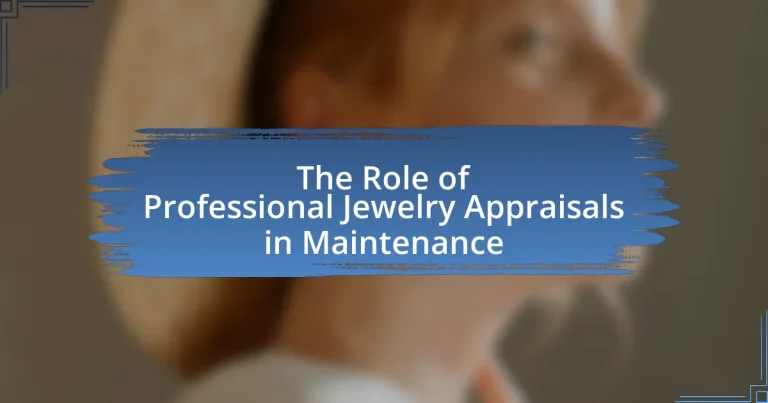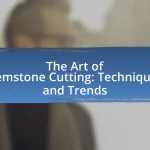Professional jewelry appraisals are essential for the maintenance and valuation of jewelry, providing accurate assessments that inform insurance coverage and care decisions. These appraisals evaluate the quality, condition, and market value of jewelry, guiding owners in necessary maintenance actions and ensuring adequate insurance protection. Regular appraisals, recommended every 2 to 3 years, help identify repairs and preserve the jewelry’s integrity, while also addressing specific considerations for different types of jewelry and gemstones. Understanding the appraisal process and selecting qualified appraisers are crucial for jewelry owners to protect their investments and make informed decisions regarding their valuable pieces.

What is the role of professional jewelry appraisals in maintenance?
Professional jewelry appraisals play a crucial role in the maintenance of jewelry by providing accurate valuations that inform insurance coverage and care decisions. These appraisals assess the quality, condition, and market value of the jewelry, ensuring that owners are aware of its worth for both financial protection and maintenance planning. For instance, having an updated appraisal can guide owners in determining appropriate insurance coverage, which is essential for protecting valuable pieces against loss or damage. Additionally, appraisals can highlight necessary maintenance actions, such as repairs or cleaning, based on the jewelry’s condition, thereby prolonging its lifespan and preserving its value.
How do professional jewelry appraisals contribute to the overall maintenance of jewelry?
Professional jewelry appraisals contribute to the overall maintenance of jewelry by providing accurate valuations and detailed assessments of condition, which inform necessary care and preservation strategies. These appraisals identify any damage or wear, allowing owners to address issues promptly, thus extending the lifespan of the jewelry. Furthermore, appraisals often include recommendations for maintenance practices, such as cleaning and storage, which are essential for preserving the integrity and appearance of the pieces. Regular appraisals also ensure that insurance coverage remains adequate, protecting the investment against loss or damage.
What specific aspects of jewelry maintenance are addressed by appraisals?
Jewelry appraisals specifically address aspects of maintenance such as valuation, condition assessment, and insurance coverage. Appraisals provide a detailed evaluation of a piece’s current market value, which is essential for determining appropriate insurance coverage. Additionally, appraisers assess the condition of the jewelry, identifying any necessary repairs or maintenance needs, ensuring that the piece remains in optimal condition. This thorough evaluation helps owners understand the importance of regular maintenance and the potential costs involved, reinforcing the need for ongoing care to preserve the jewelry’s value and integrity.
How often should jewelry appraisals be conducted for effective maintenance?
Jewelry appraisals should be conducted every 2 to 3 years for effective maintenance. This frequency ensures that the value of the jewelry is accurately reflected, accounting for market fluctuations and changes in condition. Regular appraisals help in maintaining proper insurance coverage and assist in making informed decisions regarding repairs or modifications.
Why are professional jewelry appraisals important for jewelry owners?
Professional jewelry appraisals are important for jewelry owners because they provide an accurate assessment of the jewelry’s value, which is essential for insurance purposes, resale, and estate planning. An appraisal conducted by a certified gemologist includes detailed information about the jewelry’s characteristics, such as metal type, gemstone quality, and craftsmanship, ensuring that owners have a reliable valuation. This valuation is crucial; for instance, the Gemological Institute of America states that having an up-to-date appraisal can help owners recover the full value of their jewelry in case of loss or theft.
What risks do jewelry owners face without regular appraisals?
Jewelry owners face significant risks without regular appraisals, including inadequate insurance coverage and potential financial loss. Without updated appraisals, the value of jewelry may not reflect current market conditions, leading to underinsurance. For instance, the Gemological Institute of America (GIA) emphasizes that jewelry values can fluctuate due to market trends, and failing to appraise regularly can result in owners being unable to recover the full value in case of theft or damage. Additionally, without appraisals, owners may miss identifying issues such as damage or wear, which can further decrease the item’s value over time.
How do appraisals help in maintaining the value of jewelry?
Appraisals help in maintaining the value of jewelry by providing an accurate assessment of its worth based on current market conditions, quality, and craftsmanship. This professional evaluation establishes a documented value that can be used for insurance purposes, ensuring that the jewelry is adequately covered in case of loss or damage. Additionally, appraisals can identify any changes in the jewelry’s condition over time, which can affect its value, allowing owners to make informed decisions regarding repairs or modifications. The appraisal process often includes a detailed analysis of the materials, such as gemstones and metals, and their market trends, reinforcing the importance of having an up-to-date appraisal to reflect the jewelry’s true value.

What processes are involved in professional jewelry appraisals?
Professional jewelry appraisals involve several key processes: examination, evaluation, and documentation. During the examination, a certified appraiser inspects the jewelry for its physical characteristics, including metal type, gemstone quality, and overall condition. The evaluation process involves determining the market value based on current trends, comparable sales, and intrinsic value, often utilizing industry-standard pricing guides. Finally, the documentation phase includes creating a detailed appraisal report that outlines the findings, including photographs and descriptions, which serves as an official record for insurance or resale purposes. These processes ensure that the appraisal is accurate, reliable, and useful for the owner.
How is a professional jewelry appraisal conducted?
A professional jewelry appraisal is conducted through a systematic evaluation process that includes examining the piece’s materials, craftsmanship, and market value. The appraiser begins by inspecting the jewelry for its physical characteristics, such as metal type, gemstone quality, and overall condition. They may use tools like magnifying loupes, scales, and gemological instruments to assess these attributes accurately.
Next, the appraiser researches current market trends and comparable sales to determine the item’s value. This process often involves consulting databases and industry resources to ensure an accurate appraisal. The final step is to compile a detailed report that outlines the findings, including photographs and descriptions, which serves as a formal documentation of the jewelry’s value. This methodical approach ensures that the appraisal is reliable and reflects the true worth of the jewelry in the current market.
What qualifications should a professional appraiser possess?
A professional appraiser should possess a combination of formal education, relevant certifications, and practical experience in appraisal methods. Typically, a bachelor’s degree in a related field such as finance, business, or art history is essential, as it provides foundational knowledge necessary for accurate assessments. Additionally, certifications from recognized organizations, such as the American Society of Appraisers or the International Society of Appraisers, validate an appraiser’s expertise and adherence to industry standards. Practical experience, often gained through internships or mentorships, is crucial for developing the skills needed to evaluate jewelry accurately. These qualifications ensure that appraisers can provide reliable and informed appraisals, which are critical in the maintenance and valuation of jewelry.
What tools and techniques are commonly used in jewelry appraisals?
Jewelry appraisals commonly utilize tools such as magnifying loupes, digital scales, and gemological microscopes, along with techniques like comparative analysis and market research. Magnifying loupes allow appraisers to closely examine gemstones for clarity and inclusions, while digital scales provide precise weight measurements essential for valuation. Gemological microscopes enhance the examination of intricate details, ensuring accurate assessments. Comparative analysis involves evaluating similar items in the market to establish value, and market research helps appraisers stay informed about current trends and pricing. These tools and techniques collectively ensure a thorough and accurate appraisal process.
What types of jewelry can be appraised?
Various types of jewelry can be appraised, including rings, necklaces, bracelets, earrings, and brooches. Each of these categories encompasses a range of materials such as gold, silver, platinum, and gemstones. Professional appraisers evaluate these items based on factors like craftsmanship, market demand, and material quality, ensuring accurate valuations. For instance, a diamond ring’s appraisal considers the 4 Cs: cut, color, clarity, and carat weight, which are critical in determining its market value.
Are there specific considerations for appraising antique or vintage jewelry?
Yes, there are specific considerations for appraising antique or vintage jewelry. Appraisers must evaluate the jewelry’s age, historical significance, craftsmanship, and materials used, as these factors greatly influence its value. For instance, jewelry from specific eras, such as Art Deco or Victorian, may have distinct characteristics that enhance its desirability and worth. Additionally, the condition of the piece, including any repairs or alterations, plays a crucial role in the appraisal process. Accurate appraisals often require expertise in identifying hallmark stamps and understanding market trends for antique and vintage items, ensuring that the valuation reflects both the intrinsic and collectible value of the jewelry.
How do appraisals differ for different types of gemstones?
Appraisals differ for various types of gemstones primarily due to their unique characteristics, market demand, and grading criteria. For instance, diamonds are appraised based on the Four Cs: cut, color, clarity, and carat weight, which are standardized metrics widely recognized in the industry. In contrast, colored gemstones like sapphires or emeralds are evaluated based on additional factors such as hue, saturation, and origin, which can significantly influence their value. Furthermore, the rarity of certain gemstones, such as tanzanite, can lead to higher appraisal values compared to more common stones. This differentiation in appraisal methods is supported by industry standards set by organizations like the Gemological Institute of America (GIA), which provides specific grading systems tailored to each gemstone type.

What are the benefits of regular jewelry appraisals for maintenance?
Regular jewelry appraisals for maintenance provide several key benefits, including accurate valuation, insurance coverage verification, and condition assessment. Accurate valuation ensures that the jewelry’s worth is updated, reflecting market changes and preventing financial loss. Insurance coverage verification confirms that the jewelry is adequately insured, protecting against theft or damage. Additionally, condition assessments during appraisals identify any necessary repairs or maintenance, preserving the jewelry’s integrity and appearance. These benefits collectively enhance the longevity and value of the jewelry, making regular appraisals essential for responsible ownership.
How do appraisals enhance insurance coverage for jewelry?
Appraisals enhance insurance coverage for jewelry by providing an accurate valuation that reflects the current market value of the item. This precise valuation is crucial for determining the appropriate coverage amount, ensuring that the policyholder is adequately compensated in the event of loss, theft, or damage. For instance, a professional appraisal can reveal that a piece of jewelry is worth significantly more than its original purchase price, which may not be reflected in standard insurance policies. By having an updated appraisal, typically conducted every few years, policyholders can avoid underinsurance and ensure that their jewelry is fully protected, aligning with industry standards that recommend appraisals for high-value items.
What information is typically included in an appraisal report?
An appraisal report typically includes a detailed description of the jewelry item, including its type, materials, and dimensions. It also contains information on the item’s condition, market analysis, and valuation based on comparable sales data. Additionally, the report may include photographs of the item, the appraiser’s qualifications, and any relevant certifications. This structured information ensures that the appraisal is comprehensive and supports the valuation provided, which is essential for insurance, resale, or estate planning purposes.
How can appraisal reports assist in claims processes?
Appraisal reports assist in claims processes by providing a documented valuation of jewelry, which is essential for determining the amount of compensation in the event of loss or damage. These reports include detailed descriptions, photographs, and market value assessments that establish the worth of the jewelry at the time of appraisal. For instance, insurance companies often require such reports to validate claims, ensuring that the compensation aligns with the actual value of the item. This process is supported by industry standards, such as those set by the American Society of Appraisers, which emphasize the importance of accurate and professional appraisals in facilitating fair claims settlements.
What are common misconceptions about jewelry appraisals?
Common misconceptions about jewelry appraisals include the belief that appraisals determine the resale value of jewelry and that all appraisers provide the same level of expertise. In reality, appraisals primarily establish the replacement value for insurance purposes, not resale value, which can be significantly lower due to market demand and other factors. Additionally, the qualifications and experience of appraisers can vary widely; certified appraisers with credentials from recognized organizations, such as the American Society of Appraisers, offer more reliable assessments than unqualified individuals.
Why do some people believe appraisals are unnecessary?
Some people believe appraisals are unnecessary because they perceive them as an added expense without tangible benefits. This perspective often stems from the belief that market values fluctuate and that personal sentiment or aesthetic value of jewelry cannot be quantified accurately. Additionally, individuals may feel confident in their ability to assess value based on personal experience or online resources, leading them to question the need for professional evaluations.
How can understanding the appraisal process change perceptions?
Understanding the appraisal process can significantly change perceptions by providing clarity on the value and quality of jewelry. When individuals comprehend how appraisals are conducted, including the criteria used to assess factors like craftsmanship, materials, and market trends, they gain a more informed perspective on their jewelry’s worth. This understanding can lead to increased confidence in the value of their possessions, as evidenced by a study from the Gemological Institute of America, which found that consumers who received professional appraisals felt more secure in their investment decisions. Consequently, this knowledge can shift perceptions from uncertainty to assurance regarding the financial and sentimental value of their jewelry.
What best practices should jewelry owners follow regarding appraisals?
Jewelry owners should obtain appraisals from certified professionals to ensure accurate valuation and documentation. Certified appraisers possess the necessary training and credentials, which enhances the reliability of the appraisal. Additionally, owners should seek appraisals every few years or after significant changes, such as repairs or market fluctuations, to maintain current value assessments. Keeping a detailed record of appraisals, including photographs and receipts, supports insurance claims and resale opportunities. According to the American Society of Appraisers, regular appraisals help owners make informed decisions regarding insurance coverage and asset management.
How can jewelry owners choose a reputable appraiser?
Jewelry owners can choose a reputable appraiser by verifying their credentials, such as certification from recognized organizations like the American Society of Appraisers or the International Society of Appraisers. Additionally, owners should seek appraisers with extensive experience in the specific type of jewelry being evaluated, as this expertise ensures accurate assessments. Reviews and testimonials from previous clients can also provide insight into the appraiser’s reliability and professionalism. According to a survey by the Gemological Institute of America, 85% of consumers prefer appraisers who are members of professional organizations, highlighting the importance of credentials in establishing trust.
What steps should be taken to prepare jewelry for an appraisal?
To prepare jewelry for an appraisal, first, clean the jewelry thoroughly to enhance its appearance and allow the appraiser to assess its condition accurately. Use a gentle jewelry cleaner or a mixture of mild soap and water, and ensure that all dirt and oils are removed. Next, gather any relevant documentation, such as previous appraisals, receipts, or certificates of authenticity, which can provide valuable context and support the appraisal process. Additionally, organize the jewelry in a secure, padded container to prevent damage during transport. These steps ensure that the jewelry is presented in the best possible condition, facilitating a more accurate appraisal.


